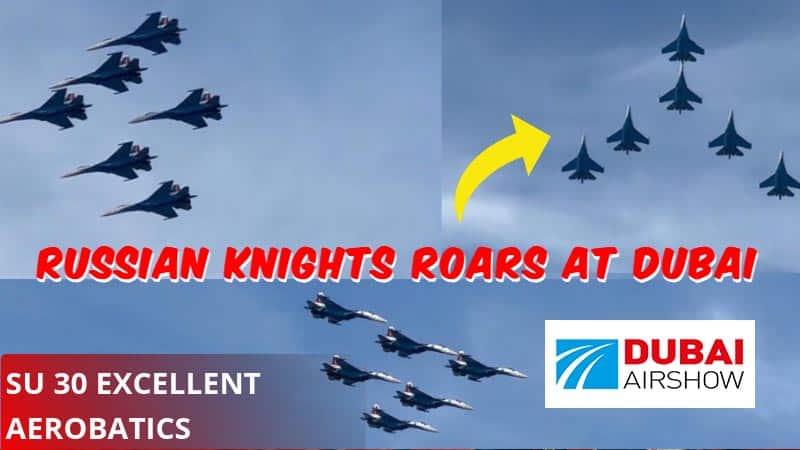Aerospace
Breaking Barriers: Russia Takes Flight at Dubai Airshow, Defying Sanctions with Aerospace Excellence

The Dubai Airshow 2023 took off yesterday, drawing the attention of numerous airlines seeking new aircraft and an upswing in demand for defense products. Over 200 aircraft, a mix of commercial and defense planes, were on display at the exhibition. Notably, Russia secured its place at the event, making a significant impact with both static and flying displays, capturing the awe of attendees.
Despite facing sanctions due to conflicts with Ukraine and Western countries, Russia boldly demonstrated its strength and self-reliance by participating in the Dubai Airshow. The country showcased its aerospace capabilities, underlining its resilience in the market.
Dubai, known for its unique location and strong bilateral ties, hosts a diverse range of participants. Middle Eastern countries, such as the UAE and Saudi Arabia, maintain strong relations with both Western and Asian countries, including Russia. The Dubai Airshow serves as an ideal platform for international business collaborations.
As one of the world’s premier aircraft exhibitions, the Dubai Airshow facilitates business engagements through product displays and the signing of memoranda of understanding (MOUs). Major players like the United States, Europe, the UK, Russia, India, and China participated in this event, presenting their cutting-edge products.
Despite facing aerospace sanctions, Russia showcased its prowess in defense products and aircraft sales. The United Aircraft Corporation (UAC), representing a significant portion of Russia’s fixed-wing aircraft output, featured products like the Ilyushin Il-76 airlifter. The Su35 aircraft of the Russian Knights display team, along with helicopters from Russian Helicopters, added to the impressive Russian presence.
Notable aircraft on display included the Sukhoi Su-30SM, Su-35S fighters, and various helicopters from Kamov and Mil. However, the Sukhoi 75 2nd 5th gen fighter jet checkmate was notably absent from the airshow. The event continues to be a focal point for aerospace companies, showcasing innovations and instilling confidence in attracting new customers.
In a daring move that has the aviation world buzzing, Russia has soared into the spotlight at the Dubai Airshow, making a captivating entrance despite facing Western sanctions. Against all odds, the nation known for its aerospace prowess has unleashed a display of innovation, resilience, and sheer determination.

Aerospace
Boeing Transfers Rocket Stage to NASA, Paving Way for Human Moon Mission

Boeing has achieved a significant milestone by providing NASA with the second core stage of the Space Launch System (SLS) rocket.
This crucial component, crafted at NASA’s Michoud Assembly Facility (MAF), is set to propel the Artemis II crew into lunar orbit, marking humanity’s return to deep space after a 50-year hiatus.
The monumental Boeing-built rocket stage, the largest element of the Artemis II mission, will embark on a journey aboard the Pegasus barge, traveling 900 miles to NASA’s Kennedy Space Center.
Comparison of two legendary aircraft B777x vs B747 aircraft:Click here
Upon arrival, it will be meticulously integrated with other essential Artemis II components, including the upper stage, solid rocket boosters, and NASA’s Orion spacecraft within the iconic Vehicle Assembly Building. This intricate integration process is a vital step toward the eagerly anticipated Artemis II launch, slated for 2025.
“Boeing-built products helped land humankind on the moon in 1969, and we’re proud to continue that legacy through the Artemis generation,” remarked Dave Dutcher, vice president and program manager for Boeing’s SLS program. “Together, with NASA and our industry partners and suppliers, we are building the world’s most capable rocket and paving the way to deep space through America’s rocket factory in New Orleans.”
NASA, Lockheed Martin Reveal X-59 Quiet Supersonic Aircraft:Click here
The delivery of Core Stage 2 marks a significant achievement in the evolution of the SLS rocket. Towering over 200 feet and powered by four RS-25 engines, this core stage, coupled with two solid-fueled booster rockets, will generate a staggering 8.8 million pounds of thrust. This immense power is crucial to launching Artemis II and future missions into the vast expanse of space.
The SLS rocket stands unparalleled in its capability to transport both crew and substantial cargo to the moon and beyond in a single launch. Its extraordinary capacity will facilitate the delivery of human-rated spacecraft, habitats, and scientific missions to destinations including the moon and Mars, ushering in a new era of space exploration.
-

 Travel1 week ago
Travel1 week agoAir India to Expand US Operations with Three New Routes After a Decade
-

 Travel2 weeks ago
Travel2 weeks agoWhy We Should Avoid These Stamps in a Passport
-

 Airlines1 month ago
Airlines1 month agoInvestigations Reveal Fake Chinese Titanium in Boeing and Airbus Jets
-

 Tech4 weeks ago
Tech4 weeks agoChina’s CATL Plans 1,800-Mile Electric Plane Launch by 2027
-

 Airport3 days ago
Airport3 days agoTop 10 Largest Airports in the World by Size
-

 Aerospace4 weeks ago
Aerospace4 weeks agoChina’s Fighter Jets Turn Wings into Autonomous Drones
-

 Airlines4 days ago
Airlines4 days agoAir India Rolls Out A350s for Delhi-New York JFK and Newark Routes
-

 Defence3 weeks ago
Defence3 weeks agoBoeing Enhances Chinook with New Engines and Block II Upgrades at $96 Million







